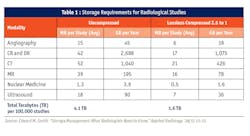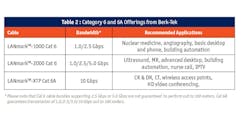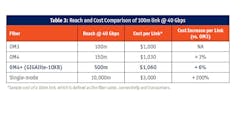The healthcare sector is experiencing explosive growth in bandwidth demand. From transmitting MRI images to wearable devices to video consultations, networks must work at higher-than-ever speeds to deliver services that ensure patient safety. It’s clear that this demand will continue to grow exponentially, putting more and more strain on your network infrastructure. Is your network designed with advanced technology that will hold up to future demands?
The internet is running out of room
Before we explore the healthcare-specific trends and requirements that are driving bandwidth demand, let’s first look at what’s happening to global IP networks as a whole.
By 2019, global IP traffic will surpass two Zettabytes annually. That means that in one year, the amount of IP traffic that travels over IP networks will be double the amount that has traversed the internet since its creation.
It is also anticipated that by 2019, there will be more than three IP devices for every person on earth. That equates to approximately 24 billion IP devices, most of which will require a unique IP address so that they can be located and identified on an IP network.
On the internet, IP traffic is transmitted via network packets, which are like envelopes that contain the voice, data, or video traffic traveling over the IP network. When a network packet is sent from one IP device to another, the device is assigned a unique IP address to define its exact identity and location. This is where the address protocols, IPv4 and IPv6 (Internet Protocol Version 4 and Version 6) come in.
IPv4 was deployed in 1981 by the Internet Engineering Task Force (IETF). IPv4 addresses are based on 32-bit identifiers, which can be used in 232 unique combinations, to create 4,294,967,296 unique IP addresses. 4.3 billion is a very limiting number, considering the fact that there will be more than 24 billion IP devices connected by 2019.
It is easy to see why a new address protocol (IPv6) was needed. (IPv5 was mostly experimental, which is why the protocol skips from v4 to v6.) In terms of the number of possible addresses, IPv6 is a game changer. It employs a 128-bit address system, which means that the number of unique IP addresses that can be created is now 340 trillion-trillion-trillion, also known as 340 undecillion.
The world of converged healthcare
It is clear that IP convergence is no longer something we talk about happening “someday.” It is upon us. We are now connecting not just computers and phones, but also security cameras, access control, lighting and TVs, as well as diagnostic equipment, nurse call stations, and parking meters. And because so much is starting to be connected, controlled, and powered through IP networks, technology has to quickly advance so that the growth of IP convergence continues.
While hospitals will normally segregate applications, particularly the medical and nonmedical, the fact remains that the prevalence of converged applications means there are more bits and bytes being transmitted and increasing the need for greater data speeds.
The data that must be created, transmitted, managed, and stored grows exponentially. In addition, regulations requiring high levels of data security to protect patient privacy add an additional layer of complexity to information management. In short, the healthcare sector is experiencing explosive growth in bandwidth demand and must work at higher-than-ever speeds.
What’s driving all this bandwidth growth?
Digital Connectivity: Medical equipment is becoming more and more digital. A clear example is the X-ray, now both filmless and digital. One benefit of this digitalization is the ability of equipment to be interconnected and IP-networked so information can be moved and shared. An X-ray film is discrete; a digital X-ray can be transmitted to any number of other pieces of equipment, from the radiology department computer to locations anywhere in the world. Almost everything that happens in a hospital now requires a network connection.
Virtual Medical Care: Adding to this complexity is the emergence of virtual medical care, sometimes referred to as telemedicine or mobile health. Virtual medical care gives people online access to physicians via mobile phone, tablet or computer 24 hours a day. It is estimated that 75% of employers offer telemedicine services in an effort to control rising health care costs. This remote medical care is adding to the already intense bandwidth requirements placed on networks by the healthcare industry.
Electronic Medical Records (EMRs): While the vast majority of medical recordkeeping is already computerized, the push for universal and uniform records is viewed as an important step to cost control and better patient care. The Health Information Technology for Economic and Clinical Health (HITECH) initiative has a goal of creating a single digital structure for all medical records to ensure compatibility in creating and accessing patient records. As EMRs contain a single repository for a patient’s complete medical history, storage requirements grow.
Exploding Storage Requirements: The amount of stored data continues to grow exponentially. A typical MRI study generates 200 images, requiring about 40 megabytes (MB) uncompressed. A multislice CT study can generate more than 2 gigabytes (GB) of data. Table 1 shows typical storage requirements for different radiological studies, based on 100,000 studies per year. The network must be able to move large files around quickly, while also handling routine transactions like email.
Wearable Devices: Wearable medical devices have grown in popularity due to their versatility and portability. These devices can take many forms, such as smart wristbands, patches worn on the skin and contact lenses, to name a few. They help both patients and doctors cut down on in-person visits by gathering data from the patient and feeding it to a database or software application for analysis, which in turn triggers a response back to the patient. The devices can perform tests, deliver treatment recommendations, or even congratulate a patient on achieving a fitness goal. All of these activities contribute to the vast amount of data being transmitted over IP networks.
Wireless: Wi-Fi is now a need-to-have in healthcare facilities, both for patient care and for overall patient and visitor satisfaction. The expectation is that it is always on, always fast, and always easy to connect to. Due to the rapidly increasing number of devices connecting and the bandwidth required for each device, wireless networks can now be quickly overloaded and frustratingly slow as a result. Ten years ago, a single wireless access point (WAP) connected by a single 1 Gbps cable could support all the wireless devices within range with no problem. Today, not only are more advanced WAPs needed (802.11ac), but more WAPs are required to cover the same square footage than what was needed ten years ago.
Cabling best practices
There are many factors to consider when planning a new or upgraded network installation. Cabling is only one piece of the network, one that is sometimes considered only as an afterthought. However, it is a very costly piece to replace. To avoid future mitigation – or worse, having to uninstall and reinstall your cabling plant – it is wise to install cable based on what your bandwidth requirements will be several years from now, rather than what they are today. This is especially important in areas dealing with patient care, from diagnostics to surgery. These areas are the ones where sufficient bandwidth capacity must be available for tomorrow’s needs.
Copper in the Horizontal
The choice of Category 6A cable over Category 6 ensures you are ready for heavy data traffic today, while equipped for migration to 10G to support future networking and bandwidth needs. With continued advancement in diagnostic imaging technologies and the growth of electronic patient records, it is safe to say that bandwidth consumption and network speeds will continue to increase over time.
Category 6A cabling is the most logical choice as it ensures 10 Gbps network performance and provides enough bandwidth to fully support emerging technologies. Table 2 shows the Category 6 and 6A offerings recommended by Berk-Tek to support various bandwidth requirements.
Fiber in the Backbone
Most backbones were installed with OM3 fiber. They supported many 1 Gbps connections out into the healthcare facility with a 10 Gbps backbone. Now, more and more network managers are installing 10 Gbps drops to support all of the emerging bandwidth-hungry applications discussed above. Those 10 Gbps drops are coming back to that same OM3 10 Gbps backbone. The problem is that there is no more buffer left in the backbone, which will cause future problems.
The next logical choice then is to move to a 40 Gbps backbone, providing a 4:1 ratio between horizontal and backbone. But when moving from a 10 Gbps to a 40 Gbps backbone, the reach of OM3 fiber decreases to only 100m. This is not nearly enough reach for most healthcare campus backbones.
Most campus environments require a maximum reach of 500 meters. The only way to achieve this required reach, without having to install a costly single-mode solution, is to install Berk-Tek’s GIGAlite-10XB OM4+ fiber along with Berk-Tek’s enhanced transceivers. Doing so provides 500 meters of reach at 40 Gbps, providing enough bandwidth to support current and future applications, without having to switch to a much more costly single-mode solution.
Table 3 compares the reach and cost of a 100-meter link, inclusive of the transceivers, connectivity, and fiber cable. The table examines the reach that each link can achieve at 40 Gbps, and notes the relative cost comparisons. Installing Berk-Tek’s GIGAlite-10XB fiber with Berk-Tek’s enhanced transceivers, you could achieve a 500-meter reach at 40 Gbps – with less than a 10% cost increase over the existing OM3 solution. No other solution on the market can offer this.
Conclusion
In a healthcare facility, an underperforming network has more than just customer service or financial implications — it could inhibit critical patient care. More than ever, healthcare infrastructures are burdened by exploding data storage, wireless access challenges, and ever-increasing bandwidth requirements. These challenges will only grow as technology continues to advance. Your cabling infrastructure must not only meet today’s needs, but those evolving on the horizon.
To learn more, join us on May 24 for a webinar on connected healthcare to learn how you can prepare for increased bandwidth. Register now.



